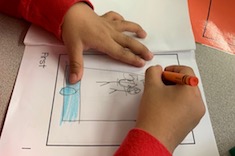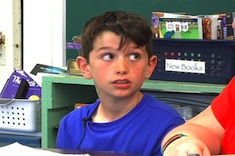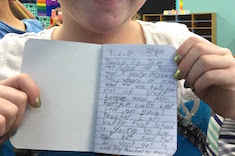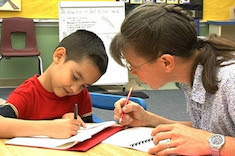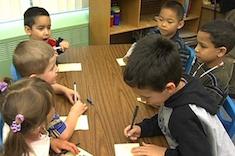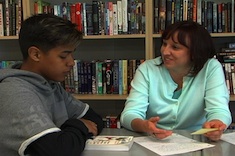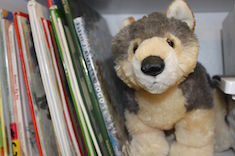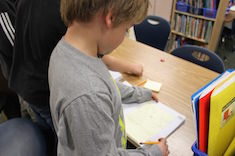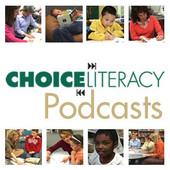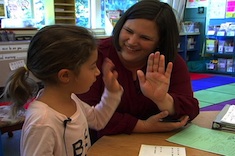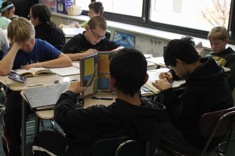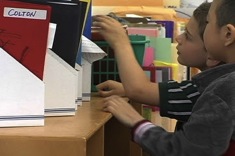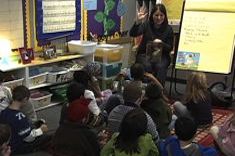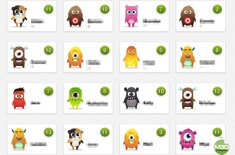Struggling and Striving Learners
It's hard work, it matters . . . and nothing brings more joy than reaching a child who is struggling. The problem is each of these students presents a unique array of challenges and needs that don't allow for a uniform approach. Here are the stories from our contributors of their breakthrough moments, one child at a time.
Latest Content
Growing Toward Stories
Tara Barnett and Kate Mills use prompts and aids to help their youngest learners tell stories and find a writing voice.
5 Strategies for Engaging Boy Writers
Jennifer Allen has been fascinated with helping boys write for years, ever since her own son insisted on writing on the same topic over and over again. She shares her five favorite strategies for boosting interest in writing among boys.
Practical Advice for Dealing with Messy Handwriting
Do struggles with handwriting matter? They do when a student can’t even decipher his own words. Katherine Sokolowski confers with fifth grader Sauvi to help him find solutions to the problem.
The Magic That Might Go Down
Christy Rush-Levine decides to slow down in her classroom and engage more fully with a student who is a wiseacre and resistant reader. What happens next can only be described as magic.
Pick a Poem
David Pittman delights in a student’s enthusiasm for poetry, leading him to reflect on how teachers often need to overcome their own negative history with poems to spark student love of the genre.
High Standards and Struggling Learners
Mark Levine explains why high standards can be helpful even for students who are struggling in his middle school classroom.
Confusing Children
Ruth Ayres explains why we can’t assume children who have experienced trauma understand the foundations and routines of how school works
Wounded Warriors: Trauma and Literacy Routines
Ruth Ayres explains which workshop routines are essential for children who come to school bearing trauma.
They Don’t Read at Home
Cathy Mere suggests strategies for working with struggling students who read very little at home.
Moves for Struggling Writers
Here are Matt Renwick's three favorite moves for helping struggling writers.
Tools for Striving Writers
Sometimes a student just. won’t. write. Melanie Meehan shares her favorite tools in her bag of tricks to get the pencil or pen moving across the page.
Using Student Checklists in Literacy Intervention
Stephanie Affinito explains how to use student checklists in literacy intervention.
Eighth-Grade Conference: Empathetic Reading
Christy Rush-Levine confers with eighth grader Julian about his strengths as an empathetic reader.
Push Pause: Dealing with Failure in the Midst
Christy Rush-Levine discovers it’s important to “push pause” to deal with failure in the midst of teaching.
Stuck at Level E
Shari Frost assists a teacher who is instructing a child stuck at level E, and in the process reveals some of the issues in treating all levels equally.
Everybody Wants to Be a Hero (and Needs a Guide)
We are wired for story, and sometimes children living hard lives need to learn how to rewrite their story. Ruth Ayres shares the teacher’s role in the process.
Bridging the Gap Between Intervention and the Classroom
Kate Mills and Tara Barnett share strategies for building bridges between intervention and classroom instruction.
Understanding Josh: The Audio Reader
Jennifer Schwanke tells the story of Josh, a special-needs student who is almost impossible to reach, until one committed teacher unlocks the key to what makes him tick as a learner.
Lester Laminack on Bullying (PODCAST)
In this podcast, Franki Sibberson chats with Lester Laminack about bullying. Lester is the author of beloved books for children and teachers including Saturdays and Teacakes and Unwrapping the Read Aloud
.
SITO: Self-Imposed Time-Out
Christy Rush-Levine takes an oddly shaped unused nook in her classroom and turns it into a charming space where students can choose to take a quiet break with a “Self-Imposed Time-Out” (SITO).
The Compliment Conference
Katrina Edwards confers with Camilla, a struggling reader. She is a child who has no confidence in herself. The Compliment Conference is a way to acknowledge and build upon Camilla’s strengths, and boost her self-esteem at the same time.
Beyond Explicit Instruction: What Do Struggling Readers Need?
Franki Sibberson explores the varied needs of young readers and writers.
Like Teacher, Like Student: Finding Emotional Support in Schools
Andie Cunningham and one of her kindergarten students share something in common at the start of the school year — tears as they struggle to find their place in a new community.
My Journey with Marcos: Autism and English Language Learners
Stella Villalba finds she needs new strategies for assisting a young autistic English language learner.
Why I Stopped Asking, “Where’s Your Pencil?”
Ruth Ayres finds the brain research is grim when it comes to the needs of neglected children, but there is still much that teachers can do to support healthy growth in students from challenging home environments.
Intervening with Read Aloud
Jan Burkins and Kim Yaris are using read alouds as an intervention strategy with struggling learners.
Surviving “That Class”
Sometimes you get a class of students that pushes every one of your buttons. Shari Frost provides a case study of one teacher’s survival strategies.
Integrating Paraprofessionals into Reading Workshops
Justin Stygles decides he needs to completely rethink the role of classroom aides.
Making Memories Stick: Tutoring Kirk
Max Brand tutors a struggling fourth grader who produces very little writing.
Learning to Observe: Inviting a Parent to a Tutoring Session
Max Brand brings a mother into the assessment process and teaches her what to observe as her child reads.
Browse Content By
Type
Category
- Assessment Tools
- Big Fresh Archives
- Booklists
- Choice Numeracy
- Classroom Design
- Common Core
- Community Building
- Conferring
- Content Literacy
- Digital Literacy
- English Language Learners
- Equity
- Family Relations
- Free Samples
- Guiding Groups
- Leadership
- Literacy Coaches
- Mentor Texts
- Minilessons
- New Teacher Mentors
- Podcasts
- Poetry
- Quote Collections
- Reading Strategies
- Self Care
- Struggling and Striving Learners
- Talking and Listening
- Teacher Study Groups
- Teaching Reading
- Teaching Writing
- Word Study and Vocabulary
Author
- Melissa Quimby
- Nawal Qarooni
- Gwen Blumberg
- Julie Cox
- The Lead Learners
- Hannah Tills
- Josie Stewart
- Ruth Metcalfe
- Mallory Messenger
- Becca Burk
- Jodie Bailey
- Vivian Chen
- Mary Brower
- Tiffany Abbott Fuller
- Stephanie Affinito
- Ruth Ayres
- Leigh Anne Eck
- Heather Fisher
- Shari Frost
- Julie Johnson
- Suzy Kaback
- Gigi McAllister
- Shirl McPhillips
- Melanie Meehan
- Cathy Mere
- Debbie Miller
- Tara Barnett and Kate Mills
- Tammy Mulligan
- Dana Murphy
- Bitsy Parks
- David Pittman
- Brenda Power
- Heather Rader
- Matt Renwick
- Mandy Robek
- Christy Rush-Levine
- Gretchen Schroeder
- Jen Schwanke
- Brian Sepe
- Katherine Sokolowski
- Stella Villalba
- Jennifer Vincent
Grade Level
Choice Literacy Membership
Articles
Get full access to all Choice Literacy article content
Videos
Get full access to all Choice Literacy video content
Courses
Access Choice Literacy course curriculum and training

